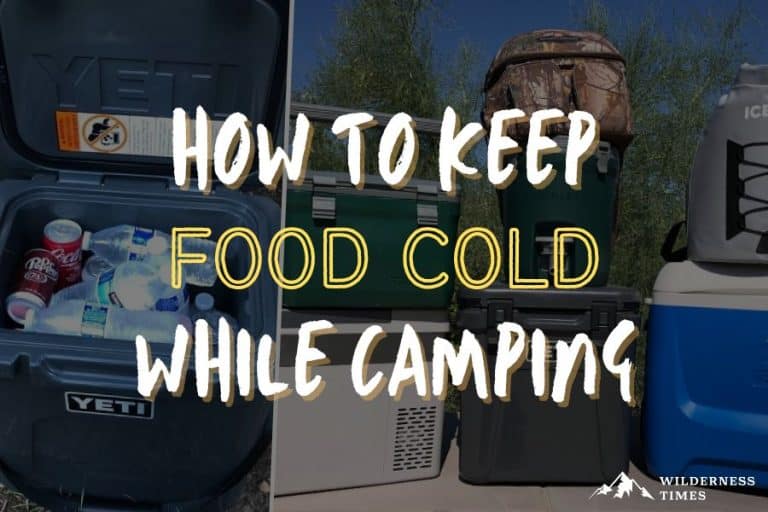What’s the greatest challenge you’ll come up against on a camping trip?
If you ask me, keeping your food fresh and cold is definitely a top contender. When camping out in the hot summer sun, perishable food can spoil super quickly if you’re not careful.
Don’t worry though, there are plenty of ways you can avoid this scenario.
In this article, we’ll share 13 great tips that’ll tell you exactly how to keep food cold while camping. We’ve also included some safety advice, to make sure you don’t end up with food poisoning on your trip.
Let’s get straight into it.
Cooler Strategies and Preparation
Get Yourself A Good Cooler (Or Two)
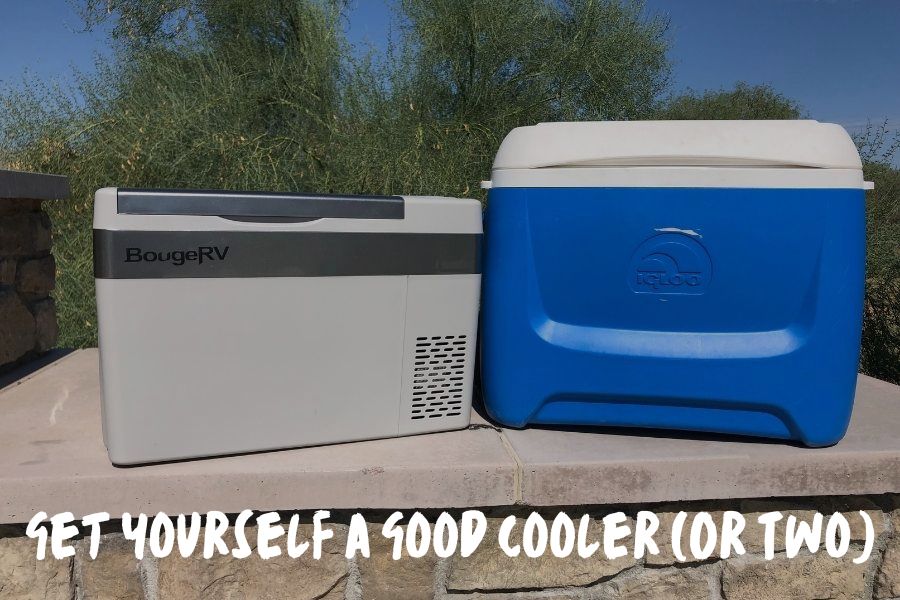
First and foremost, I definitely recommend investing in a good quality cooler.
Better yet, invest in 2 coolers. Having one for your food and another for your drinks is the way to go, but more on that further down.
You’ve basically got 4 options when it comes to coolers:
- A styrofoam cooler
- A fiberglass and steel cooler
- An electric cooler, like the BougeRV, that you can hook up to your car’s battery
- Or a soft-sided cooler like the IceMule Pro.
These are listed from the least to the most effective.
Of course, fancy electric coolers aren’t typically budget-friendly.
Fiberglass and steel coolers will do an excellent job at keeping your food fresh for up to 3 days. Be warned, however, that they are quite heavy.
Styrofoam coolers aren’t as effective, but they’re much better when it comes to portability. If you go for a styrofoam cooler, make sure it’s a high-quality one with good insulation.
Also see: The Best Cooler Brands
Chill Your Cooler Before You Head Off
If you’ve got a large enough freezer, it’s a good idea to pop your cooler in there for a few hours before you take off on your camping trip.
Chilling the cooler will increase the time it takes your ice to melt by quite a bit. This will keep your food fresh and cold for longer.
Pack Your Cooler Wisely
This one ties in with the previous tip.
Packing your cooler properly means you won’t have to open it as often. When you do have to open it, you’ll know where everything is straight away, so you won’t have to keep it open for long.
Rummaging through your cooler trying to find something is a great way to let hot air in, so you definitely want to try and keep it to a minimum.
- Put your ice at the bottom of the cooler.
- Next, stack your meat on top of the ice.
- If you have enough space, add another layer of ice over your meat.
- Dairy items go next
- Everything else should go on top.
Anything you’ll need frequently should be at the top for easy access.
One more thing you can do is fill any pockets of air with ice packs. This will help regulate the temperature inside the cooler, keeping the items towards the top just as cold as the ones at the bottom.
Make a Cooler Map
If you have a very large cooler – like a 100 quart model – it can take a while for you to find what you’re looking for. That’s especially the case if you’re using a cooler after other campmates have already been searching for snacks as well.
But there’s a way you can minimize the search time, and it involves using a good ol’ mapping system. Basically, you should organize the cooler in such a way that each thing inside has a designated spot.
For instance, meat is in the left bottom corner, drinks are right above it, veggies are in the right bottom spot, etc.
By having a map (be it a drawn or just a mental map) you can find what you’re looking for in a second, thus keeping your cooler open for a much shorter amount of time.
Ideal Cooler To Ice Ratio
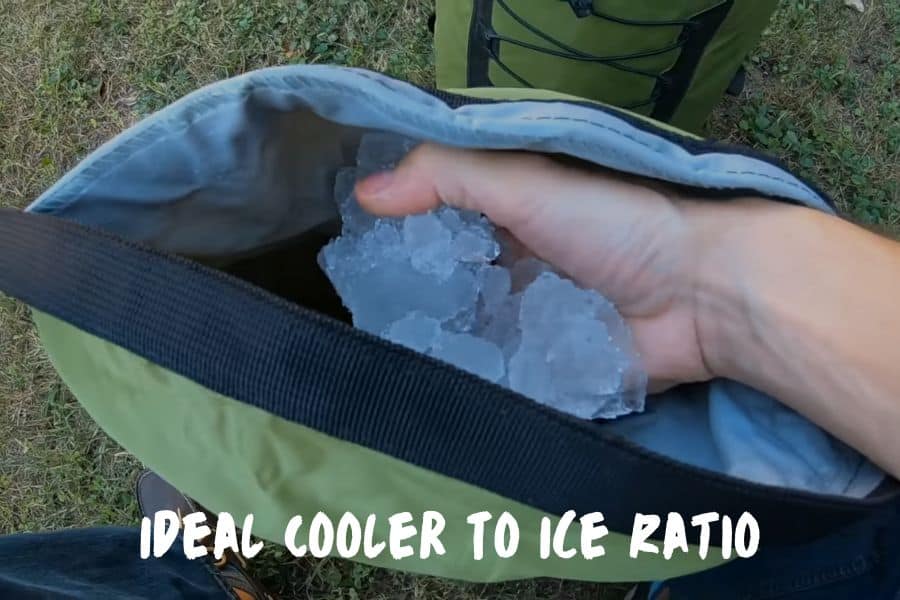
How much ice you add matters. But there’s such a thing as a perfect ratio. And in this case, it’s 2:1 ice to content. In other words, you should add twice the amount of ice for the amount of food and drinks you’re keeping in the cooler.
Can you add more ice? Sure, and it will last longer. But you’re sacrificing precious storage space for a slightly increased amount of time it stays cool.
But I definitely don’t suggest going with less than a 2:1 ratio, as your cooler won’t stay cold for long.
You might think that keeping your food cold is as simple as keeping it in a cooler. It might be, but in certain conditions, like when it’s really hot out, it might not be enough.
Your ice (especially if it’s the gas station variety) could melt in no time at all. Once that happens, it won’t be long before bacteria start to take over. Rotten meat, anyone?
To keep this from happening, you’ll want to take some extra measures to ensure your food stays fresh for as long as possible.
Food Preparation Tips to Keep It Colder for Longer
Pre-Cook Your Food
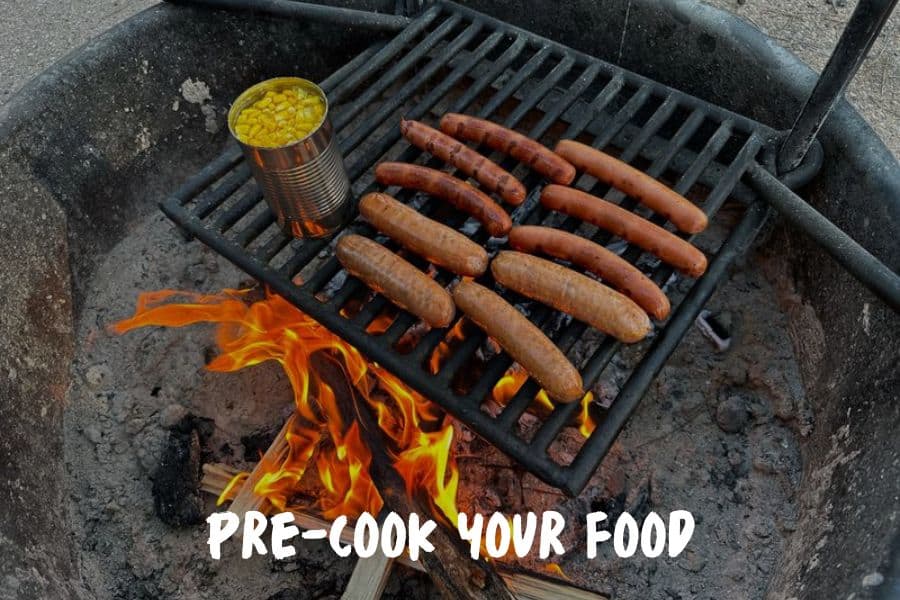
Another useful camping food trick is to pre-cook your food.
Cooked meat won’t spoil nearly as quickly as raw meat will. This is because when you cook food, you kill off a lot of the bacteria that can cause it to go bad.
You can also pre-cook entire meals, so that all you have to do is heat them up at the campsite and you’re good to go.
Need ideas? Here are some great ideas of meals you can bring camping.
Remove Excess Packaging
Most stuff you buy in grocery stores comes in unnecessarily bulky packaging.
And given that the packaging is often not even watertight, there’s really no reason why you should keep your food in it.
The same goes for drinks. Do you really need that cardboard box for your beer? I don’t think so.
To save on storage space, it’s always better to repack your food and drinks at home.
Transfer to Watertight Containers
As I already said, most stuff you buy in grocery stores comes in bulky, non-watertight packaging.
If you were to put such packaging inside a cooler, it would get soggy and your food would get wet.
You should always repack your food in watertight containers.
If you don’t have ones of appropriate size for your cooler, zip bags will do.
Just make sure to close them all the way so that water doesn’t get inside.
Freeze Your Food Before You Go
A really great way to keep your food fresh for longer is freezing it before your trip.
You can freeze everything from meat to veggies, fruit and even entire pre-cooked meals.
Your frozen food will also keep the rest of the contents of your cooler cold for longer.
If nothing else, at least freeze any raw meat you’re taking.
Raw meat will go off unbelievably quickly in the heat, and freezing it will keep it fresh for way longer.
Take Non-Perishable Backup Food
Finally, as with everything in life, make sure you have a backup plan.
If anything goes wrong and your food ends up spoiling, the last thing you want is to be left with nothing to eat. Going hungry is no fun, especially after a day packed full of camping activities.
Luckily, there are lots of food items you can take that don’t require refrigeration. So, make sure to have plenty of these on hand, just in case things go south.
Maximize Your Ice
Use Frozen Water Bottles
A great alternative to ice packs are frozen water bottles.
The great thing about using a frozen bottle is that when it thaws out, you’re left with a bottle of drinking water.
Gotta love 2 in 1 solutions that save on space when you’re camping.
Use Large Blocks Of Ice
If you do decide to use ice, make sure to use large blocks of solid ice, rather than loose ice cubes.
The ice you can pick up at your local gas station will melt way too quickly.
Large blocks of ice will take much longer to melt, keeping your food fresh for much longer. Place them at the bottom of your cooler, and stack your food on top.
Use Ice Packs
When you use normal ice in your cooler, it melts.
Melted ice will turn into a massive puddle of water that can seep into your food, turning it into a soggy mess. It can also contaminate it, making your food unsafe to eat.
You never know what kind of water was used to make the ice, unless you made it yourself. If it wasn’t pure (which, if you bought the ice, it probably wasn’t) you don’t want it getting into your food.
One way to get around this is by using ice packs instead.
You can buy them, or you can make your own ice pack by filling a freezer bag with water and rubbing alcohol at a ratio of 2:1 and freezing it.
If you decide to buy the ice packs, make sure you get good quality ice packs. (Hint: the cheap ones filled with blue gel aren’t the best.)
Try Evaporative Cooling
If you’ve got fresh fruits and veggies, you can actually keep them cool without even using a cooler.
How?
Evaporative cooling!
All you have to do is put your produce in a mesh bag (or any other porous material), wet it and hang it up in the shade. Just make sure to keep it wet by wetting the bag whenever it dries out.
The breeze, in combination with the wet bag, will keep your fruits and veggies fresh for days.
Note: this will only work with fruit and veg – don’t attempt to use this method to keep meat fresh.
Use Dry Ice
Sometimes desperate times call for desperate measures. In the case of keeping your camping food cold, desperate measures means dry ice.
It’s not as easy to come across, but dry ice is way colder than regular ice, and it takes way longer to melt.
You can also use a dry ice pack. These will keep your food fresh and cold for ages!
Keep in mind that dry ice is so cold that it’ll actually freeze your food and drinks. This is great when it comes to keeping them fresh and cold for longer. But, it’s not so great when you go to grab a cold beer, only to find it’s been turned into a beer popsicle.
Note: when you’re using dry ice in a cooler, carbon dioxide will build up inside as the ice melts. Be very careful not to inhale too much of it when you open your cooler, to avoid carbon dioxide poisoning.
Throw In Some Salt
One of my favorite tricks to have up your sleeve is salt.
Careful, though. With this one, timing is everything.
Putting salt directly onto your ice cubes will make them melt quicker, so you definitely don’t want to do that.
What you should do is wait until the ice starts melting, and then add salt. This will make the melted water colder than the ice itself.
Amazing, right?
Don’t overdo it, though. Half a handful of salt is more than enough for a large cooler.
Some Additional Tips to Keep Your Food Cold
Keep Your Cooler In The Shade
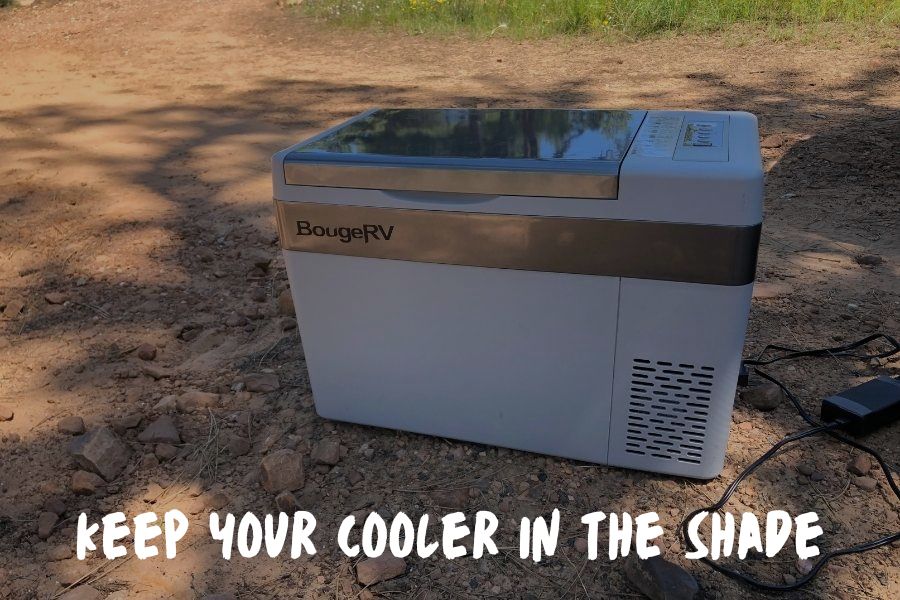
One more easy way to keep your food cold for longer is making sure to keep your cooler in the shade.
Just make sure that as the day goes on, your cooler stays in a shady spot at all times. As the sun moves across the sky, the shade provided by the trees around you will also shift. Move your cooler as needed, to keep it in the shade.
If you’re camping somewhere where there’s sand, like the beach or desert, you can also bury your cooler in the sand. This will do a good job at protecting it and keeping your contents cool, even if there isn’t any shade around.
Ensure Proper Lid Closure and No Weak Points
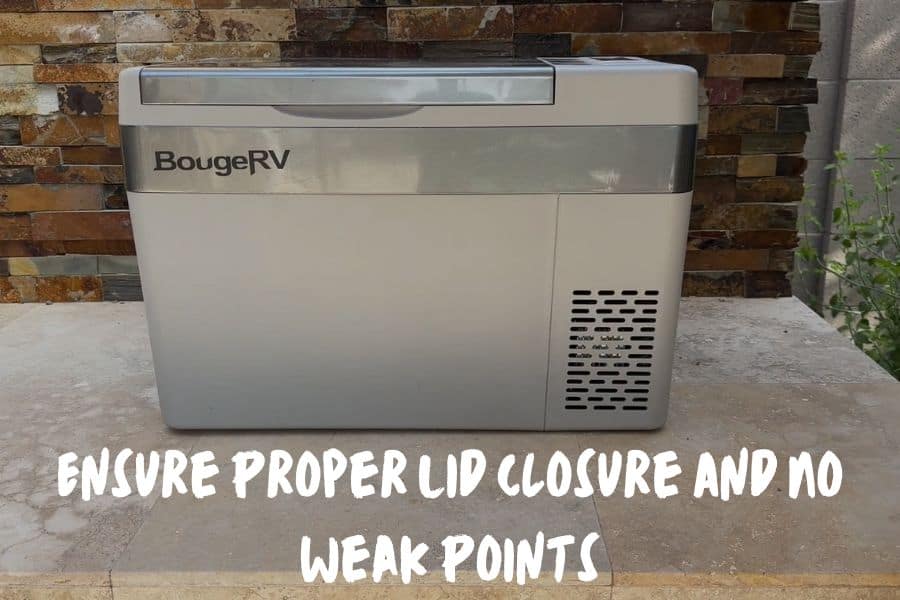
The main culprit of a cooler going warm too soon is that it’s not properly closed.
Now, I know this sounds logical, but you should know that there’s such a thing as weak points.
For instance, old coolers often get ever so slightly deformed.
That might not be so visible without detailed inspection, but your cold air from inside might be escaping the cooler.
If that’s the case, it’s always better to buy a new one. But there’s a quick fix for now.
You can tie down the lid with a guyline, or place something heavy on top of it – like a rock or another, full cooler.
That will prevent the air from escaping.
Avoid Opening Your Cooler Too Often
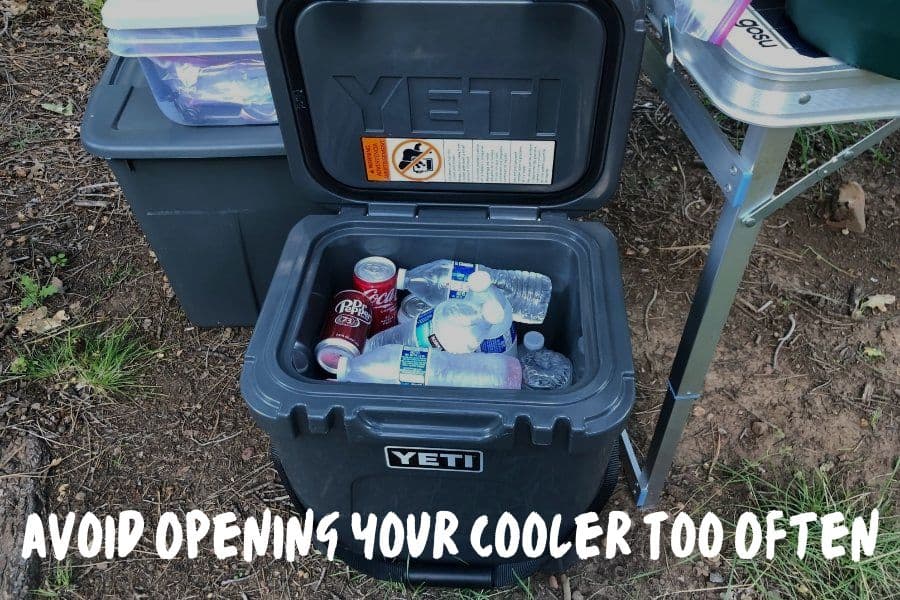
So, when I said you should get 2 coolers, this is what I was talking about.
Even if 1 cooler is big enough to fit everything you’re taking, it’s still better to have 2. If you’ve got all of your food and drinks in a single cooler, chances are you’ll be opening it way too often.
Opening your cooler every time someone wants a drink will make your ice melt a lot quicker than it would if the cooler were left closed.
This isn’t a disaster if all you’ve got in there are drinks. If, on the other hand, you’ve also got food in your cooler, you run the risk of your food going bad.
That’s why you should always keep your drinks in 1 cooler, and your food in a separate cooler.
Use A Thermometer In Your Cooler
If you want to be extra safe, you can always use a thermometer inside your cooler, to keep track of the temperature.
If the temperature rises above 40°F, you’re in the danger zone. As long as it’s below 40°F, your food will stay just as fresh and cold as it would in your fridge at home.
Food Safety Advice For Campers
Being able to keep your food cold while you’re camping is nice, but it’s also really important for your health.
As I mentioned, if your food goes off and you don’t realize, you could be looking at a nasty case of food poisoning. Not fun wherever you are, but especially not if you’re at a campsite.
So, what can you do to make sure that doesn’t happen?
Well, following the tips in this article will have you well on the way. Still, there are a couple more things you should know to be on the safe side.
First off, it’s super important that you know how long your food can be expected to last.
For instance, raw meat will only last a couple of days, even if your cooler is kept ice cold the entire time. Meat outside of the cooler, whether it’s raw or cooked, won’t be safe to eat after the first 2 hours.
Meat is definitely the riskiest, but it’s not the only thing that can give you food poisoning, so you should be just as careful with other food items. You’ve got to look out for anything that’s perishable, such as dairy, as well as fruits and veggies.
Some veggies are just fine at room temperature. In fact, a lot of veggies, such as cucumbers, tomatoes, peppers and eggplant, should be kept out of the fridge anyway.
Other veggies, such as leafy greens, mushrooms and zucchini should definitely be kept cold. Leaving them out for more than a couple of hours is not a good idea.
Make sure to thoroughly wash all of your fruits and veggies with clean water before you eat them.
Remember that your cooler should be kept at a temperature below 40°F at all times. Anything above that is warm enough for bacteria growth.
It’s a good idea to separate your ice from the rest of the cooler’s contents. You can do this by putting it in a sealed plastic bag. Or, better yet, double wrap it.
While we’re on the topic of double wrapping, I’d also recommend you double wrap any meat that’s in your cooler, to avoid cross contamination.
FAQs
How long can things stay cold in a cooler?
That depends on the material and quality of the cooler.
Most soft-sided coolers keep your stuff cold for up to a day, while hard-sided coolers can last for days.
How long will a bag of ice last in a cooler?
This also depends on the quality of your cooler. One bag of ice can last anywhere between 12 hours and several days.
How do you keep ice from melting when camping?
First things first, keep your cooler in a shaded spot. If possible, you can dig out a hole in the ground to bury the bottom part.
The ground underneath is colder than the one on the surface, so it can help in keeping your ice cooler for longer.
Does aluminum foil keep ice from melting?
It can definitely help, but it won’t do magic.
By lining the inside, you can keep the light and heat reflecting, thus keeping your ice from melting for a longer period of time.
Wrapping It Up
Now, to wrap things up. I mean the article, but yes, your food as well.
As you can see, keeping your food fresh and cold while camping isn’t as hard as it might seem.
You don’t need any fancy, state-of-the-art equipment. All you need is a good cooler and a few tricks under your belt to get the most out of it.
Food poisoning is no joke, so I generally stick to the rule: when in doubt, throw it out. It’s always better to be safe than sorry.
Oh, and don’t forget, once you are back home, make sure to thoroughly clean out your cooler to have it ready for the next trip!


